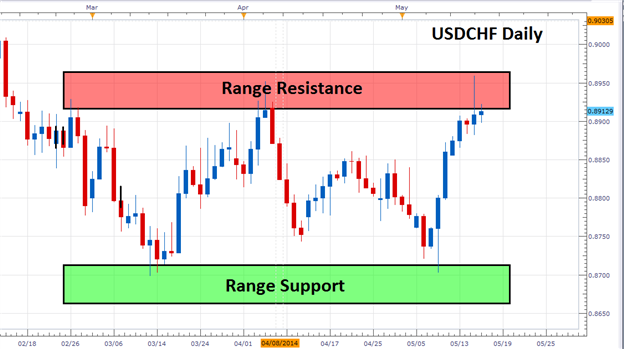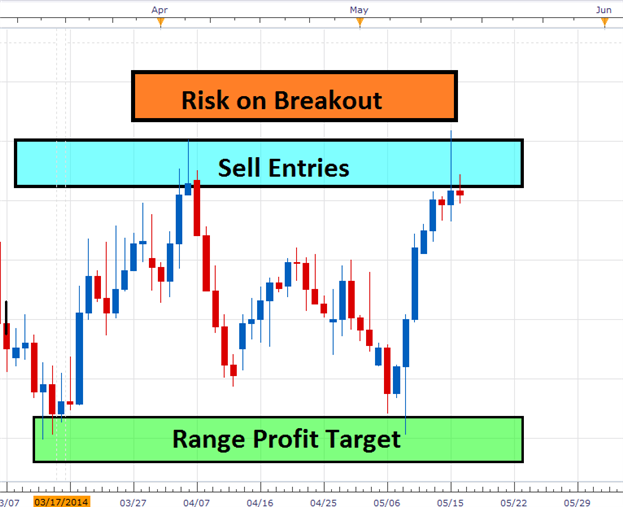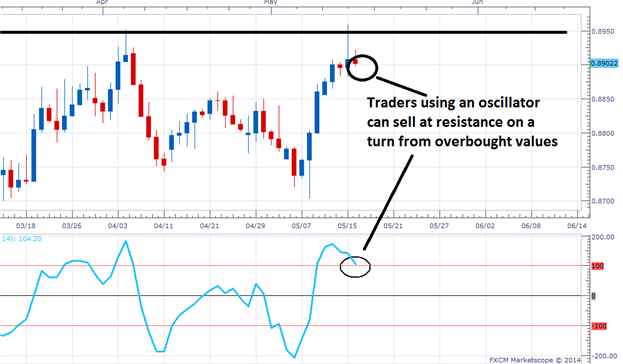Talking Points
- Range markets can provide opportunities for observant traders
- The USDCHF has reached a point of resistance in a Daily Range
- Traders can use oscillators to confirm entries for their strategy
Have you ever experienced a market that seemed to be going nowhere fast? When the market lacks direction, this may seem as a deterrent to traders. However, the opposite is quite true! Sideways markets are known as ranges and can provide trading opportunities for the observant trader. Today we examine an example of the range developing on the USDCHF and discuss techniques to trading this technical setup.
First traders must learn to identify a range. The good news is, ranges are some of the easiest to pinpoint through the use of horizontal support and resistance lines. These areas can be found by connecting a series of high and low points on your graph. Below we can see our example on the USDCHF. A line of resistance has been formed by connecting the April 4th and May 15th peaks. The lows from March 3rd and May 8th have been connected to form acting support.
Learn Forex – USDCHF Daily Range

Trading The Range
Once a range has been identified, traders need to develop a plan for order execution. The easiest way to go about trading a range is to wait until the market reaches the previously mentioned points of support or resistance. Since the range is a directionless based strategy, traders will look to sell resistance, and look to buy areas of support.
Once a trade has been placed, risk can be managed through a stop placed outside of the identified lines of support and resistance. That way trades will be exited in the event of a breakout. Traders can then set profit targets at the opposing point of the range. This will allow traders to complete a positive risk reward ratio while range trading by making more pips in the event of a profitable position, relative to the amount risked in the event of a loss.
Learn Forex – Trading The Range

(Created using FXCM’s Marketscope 2.0 charts)
Confirming Entries
One final technique for trading ranges, involves employing an oscillator on entry. This step can be added to any range trading plan to pinpoint an entry into the market. This can be done by aligning an oscillators overbought and oversold levels with the previously mentioned lines of support or resistance values. Let’s look at an example of how this may work.
Here again is our example on the USDCHF daily chart. Notice how price has tested resistance and traders may now be looking to execute fresh sell positions. Traders may choose to wait patiently and only enter a fresh order when an oscillator, such as CCI , returns from an overbought position. This signal can be a strong indicator of momentum heading back towards support, providing an additional execution trigger. Once this is done, traders may then continue setting up stop and limit orders as previously mentioned.
Learn Forex – USDCHF Range with CCI

(Created using FXCM’s Marketscope 2.0 charts)
Now that you are a little more familiar with trading ranges, you can begin practicing your trading. You can get started following prices for your favorite currency pairs including the USDCHF, EURUSD and others by signing up for a Free Fore x Demo with FXCM. This way you can develop your trading skills while tracking the market in real time!
---Written by Walker England, Trading Instructor
To contact Walker, email [email protected] . Follow me on Twitter at @WEnglandFX.
To be added to Walker’s e-mail distribution list, CLICK HERE and enter in your email information.
